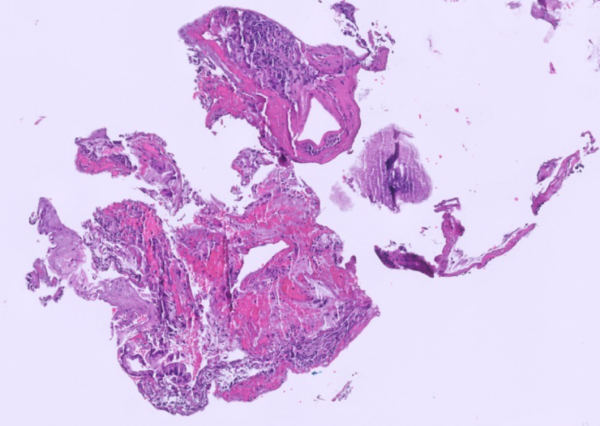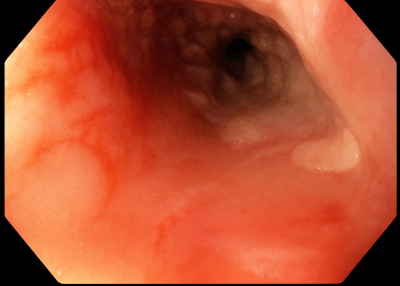Sunday Poster Session
Category: Pediatrics
P1899 - A Rare Presentation of Severe Eosinophilic Esophagitis (EoE) in a 15-Month-Old With 3q29 Microdeletion Syndrome
Sunday, October 26, 2025
3:30 PM - 7:00 PM PDT
Location: Exhibit Hall

Amy Yeung, DO (she/her/hers)
Valley Health System, Icahn School of Medicine at Mount Sinai
Paramus, NJ
Presenting Author(s)
Amy Yeung, DO, Lauren Dankner, MD, Robert Mazziotta, MD, Rose Bishop, MGC, LCGC, Sita Chokhavatia, MD, MACG
Valley Health System, Icahn School of Medicine at Mount Sinai, Paramus, NJ
Introduction: 3q29 microdeletion syndrome, a rare autosomal dominant and often de novo disease, includes neurodevelopmental features, intellectual disability, autism spectrum disorder, gastroesophageal reflux disease (GERD), and feeding difficulties. EoE has not been previously reported in association with this syndrome. We present a case of a 15 month boy with chronic emesis secondary to severe EoE.
Case Description/
Methods: An ex-full term 15 month old male presented with persistent nonbilious emesis after feeding. He was unable to progress from goat milk formula and pureed foods to solids despite months of feeding therapy. He had delayed motor (fine and gross) and language skills (expressive and receptive).
He was a full-term cesarean delivery due to breech presentation and oligohydramnios, with uncomplicated postnatal course. Weight was 96th percentile for age and 93rd percentile for height. Family history was non-contributory. Aside from developmental delays, the physical examination was normal. Labs including metabolic panel and thyroid studies were normal and there was mild microcytic anemia (hemoglobin 10.9 g/dL, mean corpuscular volume 72.8 fL). Exome sequencing in trio identified a de novo multi-gene deletion within the recurrent subterminal deletion region of 3q29. Upper gastrointestinal series, abdominal ultrasound, and brain magnetic resonance imaging were normal.
Esophagogastroduodenoscopy (EGD) revealed severe congestion, erythema, ulceration and sloughing throughout the esophagus. (Figure 1a). Histologically, there was evidence of sloughing with fibrinous exudate, neutrophilic and eosinophilic inflammation, and ulcers (Figure 2b).
After eight weeks of high-dose pantoprazole (2 mg/kg/day divided twice daily), repeat EGD showed improvement in ulceration and presence of linear furrowing, suggestive of EoE, which was confirmed on histology with abundant eosinophils.
Discussion: While GERD is commonly documented in children with 3q29 microdeletion syndrome, EoE may be an underrecognized contributor to feeding difficulties in this population. Any child with feeding delays should prompt early endoscopic evaluation. To our knowledge, this is the first reported case of biopsy confirmed EoE in a child with 3q29 microdeletion syndrome. Early endoscopy and an integrated care model (feeding therapy and developmental support) are key to improving outcomes.

Figure: Figure 1a: Esophageal inflammation with severe congestion, sloughing, and ulceration.

Figure: Figure 1b: Gastroesophageal junction biopsy with acute inflammation, erosion, and sloughing.
Disclosures:
Amy Yeung indicated no relevant financial relationships.
Lauren Dankner indicated no relevant financial relationships.
Robert Mazziotta indicated no relevant financial relationships.
Rose Bishop indicated no relevant financial relationships.
Sita Chokhavatia indicated no relevant financial relationships.
Amy Yeung, DO, Lauren Dankner, MD, Robert Mazziotta, MD, Rose Bishop, MGC, LCGC, Sita Chokhavatia, MD, MACG. P1899 - A Rare Presentation of Severe Eosinophilic Esophagitis (EoE) in a 15-Month-Old With 3q29 Microdeletion Syndrome, ACG 2025 Annual Scientific Meeting Abstracts. Phoenix, AZ: American College of Gastroenterology.
Valley Health System, Icahn School of Medicine at Mount Sinai, Paramus, NJ
Introduction: 3q29 microdeletion syndrome, a rare autosomal dominant and often de novo disease, includes neurodevelopmental features, intellectual disability, autism spectrum disorder, gastroesophageal reflux disease (GERD), and feeding difficulties. EoE has not been previously reported in association with this syndrome. We present a case of a 15 month boy with chronic emesis secondary to severe EoE.
Case Description/
Methods: An ex-full term 15 month old male presented with persistent nonbilious emesis after feeding. He was unable to progress from goat milk formula and pureed foods to solids despite months of feeding therapy. He had delayed motor (fine and gross) and language skills (expressive and receptive).
He was a full-term cesarean delivery due to breech presentation and oligohydramnios, with uncomplicated postnatal course. Weight was 96th percentile for age and 93rd percentile for height. Family history was non-contributory. Aside from developmental delays, the physical examination was normal. Labs including metabolic panel and thyroid studies were normal and there was mild microcytic anemia (hemoglobin 10.9 g/dL, mean corpuscular volume 72.8 fL). Exome sequencing in trio identified a de novo multi-gene deletion within the recurrent subterminal deletion region of 3q29. Upper gastrointestinal series, abdominal ultrasound, and brain magnetic resonance imaging were normal.
Esophagogastroduodenoscopy (EGD) revealed severe congestion, erythema, ulceration and sloughing throughout the esophagus. (Figure 1a). Histologically, there was evidence of sloughing with fibrinous exudate, neutrophilic and eosinophilic inflammation, and ulcers (Figure 2b).
After eight weeks of high-dose pantoprazole (2 mg/kg/day divided twice daily), repeat EGD showed improvement in ulceration and presence of linear furrowing, suggestive of EoE, which was confirmed on histology with abundant eosinophils.
Discussion: While GERD is commonly documented in children with 3q29 microdeletion syndrome, EoE may be an underrecognized contributor to feeding difficulties in this population. Any child with feeding delays should prompt early endoscopic evaluation. To our knowledge, this is the first reported case of biopsy confirmed EoE in a child with 3q29 microdeletion syndrome. Early endoscopy and an integrated care model (feeding therapy and developmental support) are key to improving outcomes.

Figure: Figure 1a: Esophageal inflammation with severe congestion, sloughing, and ulceration.

Figure: Figure 1b: Gastroesophageal junction biopsy with acute inflammation, erosion, and sloughing.
Disclosures:
Amy Yeung indicated no relevant financial relationships.
Lauren Dankner indicated no relevant financial relationships.
Robert Mazziotta indicated no relevant financial relationships.
Rose Bishop indicated no relevant financial relationships.
Sita Chokhavatia indicated no relevant financial relationships.
Amy Yeung, DO, Lauren Dankner, MD, Robert Mazziotta, MD, Rose Bishop, MGC, LCGC, Sita Chokhavatia, MD, MACG. P1899 - A Rare Presentation of Severe Eosinophilic Esophagitis (EoE) in a 15-Month-Old With 3q29 Microdeletion Syndrome, ACG 2025 Annual Scientific Meeting Abstracts. Phoenix, AZ: American College of Gastroenterology.
